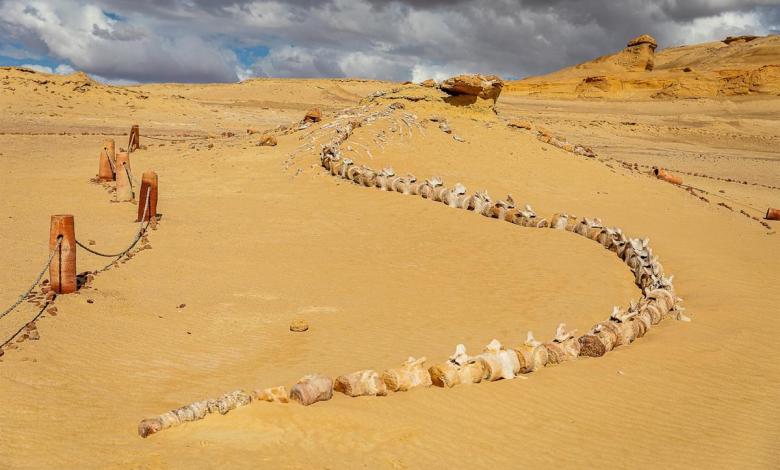Visit Egypt’s Valley of the Whales for a window into evolutionary history

This article was produced by National Geographic Traveler (UK).
Ancient Egyptian history is brought to life by thousands of people, from Tutankhamun’s glazed death mask to the magnificent Sphinx tower. But drive 100 miles southwest of Cairo into the vast sandscape of the Western Desert, and you can see the clock wind back even further — to a time when Egypt was inhabited not by kings but by monsters.
Here, at the end of a long, unsealed road is Wadi al-Hitan, a 75sq-mile UNESCO World Heritage Site said to hold the key to one of the great mysteries of evolution.
You wouldn’t think so looking at it. There is no life in this valley of sand: no houses, no trees, no water – just kilometer and kilometer of all-encompassing desert, endless and as golden as all the treasures of Pharaoh put together. After the chaos of Cairo, the silence is profound.
Although travelers flock to see the treasures of Ancient Egypt in the Valley of the Kings, Wadi al-Hitan remains a hidden treasure. Yet this remote area tells a powerful story of life on Earth, buried by the original sands of time and now brought to the surface by wind erosion and the painstaking work of paleontologists.


Fossil fans often visit the valley on a day trip from Cairo. What they find among the sands are rocks carved into unusual shapes over millennia. Bulbous pavilions, squat rotundas and giant toadstools dot the area, marked by a never-ending atmosphere. Between them is a sandy path, distinguishable from the rest of the desert only by the clean stones arranged at its edges and the passing steps of tourists.
This is one of the most barren places on Earth and yet, as the hike slowly grinds its way up through the monstrous rocks, there are signs of prehistoric life: smooth mollusc shells may catch the light; there are bullet-shaped fossils of sea creatures called nummulites to be found; even shark teeth can be found here.
They confuse things you can find in a desert 100 miles from the coast, but 40 million years ago the shape of the continents was very different and all of what is now North Africa was submerged under a shallow ocean called Tethys.


There are also huge clues to this mysterious past – bone fragments scattered like puzzle pieces, vertebrae the size of concrete blocks. But most surprising and surprising is the well-preserved skeleton of a large predator lying in the sand at the end of the path, its spine the length of a cricket field, its ribs blown out on either side like stumps knocked down by spin. the thrower.
“When scientists first discovered this creature, they thought it was a large marine reptile,” said Hesham Sallam, a leading biologist at Wadi al-Hitan. “So they named it Basilosaurus, which means ‘king lizard’. It was only later that they realized it was actually an ancient whale.”
Palaeontologists have been uncovering prehistoric whales here for over a century. About 1,000 people have been identified, making this the largest cemetery in the world, and one of the most important palaeontological sites. That’s why, in a nod to Egypt’s most famous burial ground – the Valley of the Kings – they named it Wadi al-Hitan, the Valley of the Whales.
There are about a dozen whale bones for visitors to explore among the sands, all of which have been identified as prehistoric Basilosaurus or Dorudon. They are about 37 to 40 million years old, which means they lived in the Eocene period. Placed as an open exhibition, their remains are connected by paths so that visitors can follow each one.


The bones are interesting to examine, but they are also important for understanding one of the most mysterious stories of evolution – and the key to this can be found in the small, underground museum of Wadi al-Hitan.
Here, alongside meter-long Basilosaurus skulls baring monstrous teeth, the monster’s most striking (and oddly amusing) feature: tiny hind legs, complete with thigh bones, clavicles, ankles and matchstick feet.
“If you think about it, it’s strange that whales are mammals that breathe air, but they live in the sea,” explained Sallam. “Scientists think they came from the ground, but later they entered the water and turned into the giants we know today, they lost their legs. But for decades they had no evidence.”
These leg bones, discovered in 1989, are an important link in that transition. They are small, bigger than a human arm, and attached to this six-ton whale they would not help moving. But they are clear evidence that whales once lived on land and gave up their earthly life to return to the sea.
“It’s like seeing evolution with your physical eye and touching it with your hand,” said Sallam. “You have to be careful where you walk, because there are fossils everywhere and you never know what’s new under your feet.”
To register National Geographic Traveler (UK) click on magazine here. (Available in selected countries only).
Source link




